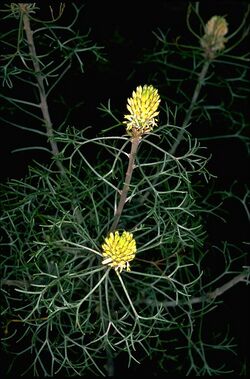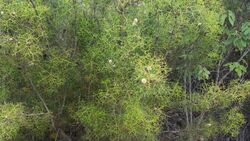Biology:Petrophile sessilis
| Conesticks | |
|---|---|

| |
| Petrophile sessilis near Bylong | |
| Scientific classification | |
| Kingdom: | Plantae |
| Clade: | Tracheophytes |
| Clade: | Angiosperms |
| Clade: | Eudicots |
| Order: | Proteales |
| Family: | Proteaceae |
| Genus: | Petrophile |
| Species: | P. sessilis
|
| Binomial name | |
| Petrophile sessilis Sieber ex Schult.[1]
| |
| Synonyms[1] | |
| |
Petrophile sessilis, known as conesticks,[2] is a species of flowering plant in the family Proteaceae and is endemic to New South Wales. It is an erect shrub with rigid, needle-shaped, divided, sharply-pointed leaves, and oval, spike-like heads of silky-hairy, creamy-yellow flowers.
Description
Petrophile sessilis is an erect shrub that typically grows to a height of 3 m (9.8 ft) and has branchlets and leaves that are silky-hairy when young but become glabrous with age. The leaves are 30–100 mm (1.2–3.9 in) long and divided with rigid, sharply-pointed, needle-shaped pinnae usually less than 10 mm (0.39 in) long. The flowers are arranged on the ends of branchlets and in leaf axils in spike-like, oval heads 20–25 mm (0.79–0.98 in) long, with broadly egg-shaped involucral bracts at the base. The flowers are 10–14 mm (0.39–0.55 in) long, silky-hairy and creamy-yellow. Flowering mainly occurs from May to February and the fruit is a nut, fused with others in a oval head up to 35 mm (1.4 in) long.[2][3] It can be distinguished from the related Petrophile pulchella by its finely hairy new growth.[4]
Taxonomy
Petrophile sessilis was first formally described in 1827 by Josef August Schultes in the 16th edition of Systema Vegetabilium from an unpublished description by Franz Sieber.[5][6]
Distribution and habitat
Petrophile sessilis grows on sandstone soils in heath, woodland and forest from the Central Coast to the Central and Southern Tablelands of New South Wales.[2][3]
References
- ↑ 1.0 1.1 "Petrophile sessilis". Australian Plant Census. https://biodiversity.org.au/nsl/services/apc-format/display/60812.
- ↑ 2.0 2.1 2.2 Harden, Gwen J.. "New South Wales Flora Online: Petrophile sessilis". Royal Botanic Gardens & Domain Trust, Sydney, Australia. http://plantnet.rbgsyd.nsw.gov.au/cgi-bin/NSWfl.pl?page=nswfl&lvl=sp&name=Petrophile~sessilis.
- ↑ 3.0 3.1 Foreman, David B.. "Petrophile sessilis". Australian Biological Resources Study, Department of Agriculture, Water and the Environment: Canberra. https://profiles.ala.org.au/opus/foa/profile/Petrophile%20sessilis.
- ↑ Harden, Gwen J.. "New South Wales Flora Online: Genus Petrophile". Sydney, Australia: Royal Botanic Gardens & Domain Trust. http://plantnet.rbgsyd.nsw.gov.au/cgi-bin/NSWfl.pl?page=nswfl&lvl=gn&name=Petrophile.
- ↑ "Petrophile sessilis". APNI. https://id.biodiversity.org.au/instance/apni/466080.
- ↑ Schultes, Josef August; Schultes, Julius Hermann (1827). Mantissa in volumen primum [-tertium :Systematis vegetabilium caroli a Linné : ex editione Joan. Jac. Roemer et Jos. Aug. Schultes]. Stuttgart. p. 262. https://www.biodiversitylibrary.org/item/10317#page/265/mode/1up. Retrieved 7 January 2021.
Wikidata ☰ Q7179056 entry
 |


